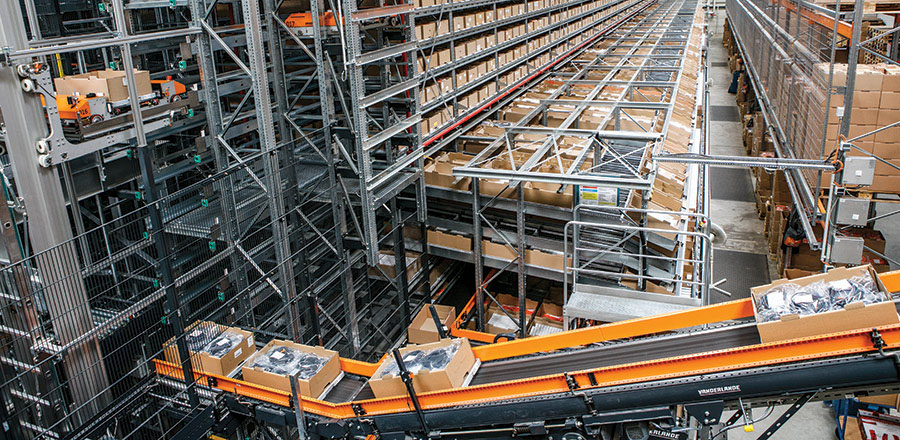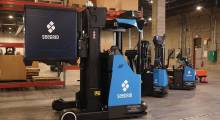By now, many readers’ peak seasons have begun to wind down. Of course, that means strategizing for next year can begin in earnest. But for those seeking to modernize distribution operations, plenty of reasons can be found to be optimistic as the new year unfolds. Sure, the labor market remains bleak and service levels somehow keep getting more demanding, but the hardware and software to meet those challenges has come a long way in recent years.
Automated storage and retrieval systems (AS/RS) are prominent in this new solution mix for operations of all sizes. Most AS/RS systems are designed specifically to offset fluctuations in labor, volume and SKU/order profiles. Still, the pace of change has shifted the goalposts farther to the extremes.
Modularity and flexibility are now the driving forces behind innovation as automation seeks to shed its legacy as a fixed, long-term commitment only for those with deep pockets and massive facilities. In fact, as solution providers describe it, that legacy is officially old news.
“With the rise of robotics and new automated solutions, you can make plans that are different than five years ago,” says Jerry Johnson, business development manager for Vanderlande Industries. “That growth plan was basically your only option, and you had limited decisions in response to change. Now, there are more flexible growth opportunities.”
Charting the course
Given the unpredictability of the market and our behavior as consumers, Johnson says, it can be hard to plan. In the coming years, will you need more throughput or more SKUs or will the quantity of items per order change? Any technology that potentially restricts nimbleness in the face of those possibilities is a non-starter. In recent years, as the entire industry sought to clear out the cobwebs of pre-Amazon operations, the conversations around investment in automation were exceedingly cautious.

Automated storage can support the flexibility to meet peaks as needed while reducing temporary labor by 70%.
“With that caution, a past project might typically have a target or peak year three to five years after go-live,” Johnson says. “Today customers are considering seven to 10-year horizons, and one project had an even longer plan for their DC.”
Whatever the size or scope of the project, Johnson says activity and investment are growing at “tremendous” levels. The confidence boost comes from a better understanding of how to phase a project to ensure flexibility.
“The most important thing is that it provides us with a better opportunity to do a good job, find the right solution, and define the right way to get scalability into the designs,” Johnson says.
Shuttles once bound to a single aisle can now move from one to another. You can add extra shuttles and lifts to boost throughput without adding extra aisles. Want to move an AS/RS from one location to another inside a facility, or to another facility altogether? No sweat. Additionally, the latest software stands ready to easily support these changes. This flexibility is supported by the growing popularity of the microservices architecture for software—an approach that allows for compact, less expensive and really modular hardware and software elements.
“Especially with microservice-based IT products coming up, that means you can create software that’s far more modular. I mean really modular,” Johnson says. “It makes it extremely simple to just add new functionalities. So if you want to add batching, it’s easy. We now have a true plug-and-play process.”
Ken Ruehrdanz, manager of the distribution systems market for Dematic, says increased standardization and less customization makes system support a much simpler process for customer and system supplier.
“In the past if you ever needed support, it was for a one-off system. As a user, I don’t want to be the only one using this solution,” Ruehrdanz says. “An AS/RS—or any materials handling automation—is an ongoing, living solution that is constantly being adjusted. It’s very rare to put one in and have it just stay the same.”
So when 10,000 new SKUs come along, the software and controls can stay identical, but the system will be ready to handle a different tote size or load-handling devices.
The workstations at the AS/RS are another area where adaptability is important. In the early phases of goods-to-person solutions, Ruehrdanz says stations were very customized and performance varied from one to another. Now that they are standardized, pre-tested and pre-engineered, they can provide more predictable system performance.
For example, the modular workstation might have started as a 1:1 setup with a single donor tote and single order tote at a time. If the activity profile changes and it now makes sense to fulfill retail and e-commerce orders, the station can be easily adjusted to a 1:6 setup handling six orders at a time. Modular hardware and software mean that transition can occur in a matter of days as opposed to several weeks.
To verify the effectiveness of any modifications before peak, Chris Capshaw, executive director of logistics solutions sales for SSI Schaefer Systems International, recommends simulations—virtual and real. This will prove out throughput and efficiency while highlighting any shortcomings with slotting or other strategies. Test runs might include allowing the system to be backed up under controlled conditions and then releasing the pent-up orders to simulate peak volume.
Having identified that being able to sell more SKUs is an advantage, Capshaw says many companies are focused on a system’s ability to add SKUs, either by organic growth or as the result of an acquisition or other one-time spike in SKU count. This strategy is among the factors driving increased focus on direct case handling to either supplement or replace decanting into totes.
Reverse logistics
Getting orders out the door is one thing, but processing returns is a fundamental element of system design for e-commerce companies. “Online shopping continues to increase, and the percentage of returns is now significant enough that the volume is there to think about automating it,” Ruehrdanz says. “The business case is becoming stronger.”
Ruehrdanz says pouch sorters are a great fit for these companies due to their ability to act as a sorter, buffer and temporary storage. After a return is checked in, refunded and identified for potential repackaging, it can be placed in the pouch sorter.
“It then stays in suspended animation, so to speak, until another order comes in for that item,” he says. “It’s more effective since you don’t have to put it back into storage.”
Pocket sortation systems could also be an alternative to unit sorters and put walls. Put walls will remain a viable option, but Capshaw says they can require more labor and two to three more touches per order. Alternatively, the larger initial investment in pouches is compatible with robotic loading where a robot places items on a conveyor that then drops items into a pouch. Pouch sorters rated for 3-kilogram loads are suited to fashion items, while a 10-kilogram model might be better suited to general merchandise.
“What’s really driving small and medium-sized businesses to automate is labor availability,” Capshaw says. “If they were used to hiring 2,000 through peak before, afterward they might need only 600.”
Modularity and scalability of AS/RS systems also lends itself to smaller systems, which are not exclusively appealing to small operations. Even large companies are developing what the industry is calling “micro-fulfillment centers,” Ruehrdanz says. The concept might consist of an automated system in the back of a retail store where high density is ideal. Inventory in such systems is then used for fulfilling online orders or buy online, pick up in store (BOPIS) orders. This prevents in-store pickers from competing with walk-in customers, alleviates pressure on regional DCs and enhances responsiveness to local customers. This has already begun with grocery companies, Ruehrdanz says, but will soon move into general merchandise.
Another variant of the micro-fulfillment center is a stand-alone facility in a high-traffic urban area that acts only as a pick-up center or place to dispatch delivery trucks. Until lately, few would think of putting a warehouse in an urban area, but AS/RS can ensure such a facility is compact and efficient. A shuttle-based inventory storage and goods-to-person workstation can reduce order fulfillment cost and processing time.
A goods-to-person system can make any retail store employee productive, but Ruehrdanz notes the increasing popularity of goods-to-robot variants.
“We see a trend of using goods-to-robot for piece picking,” he says. “It’s small now, but there’s a significant growth potential. That trend will bring the AS/RS along with it.”
Vanderlande’s Johnson also emphasizes the micro fulfillment center trend, where the building of future central DCs will be accompanied by nearby specialty satellites.
“If the ideal solution is more storage-driven or throughput-driven, that can help us decide the direction of the technology used,” Johnson says. “Do you anticipate an increase in picking, storage or value-added services, even something as simple as a paper wrap? We can work with a client to understand that and prepare them for future success.”
Companies mentioned in this article:
Article topics









